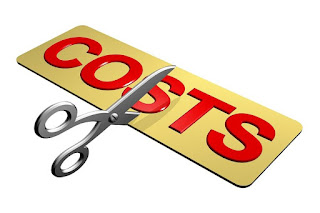The previous post noted that 1%
is bigger than you think relative to your dividend stream and the
period of time required for it to double in size. The concept involves compound
annual growth rates (CAGR) and the Rule
of 72.
I finished by saying I’d share ways to increase the compound
growth rate of a div stream by at least 1%.
Here goes…
Transactions Costs
There are two items involved here. One is the actual cost of buying a
stock. The other is a function of
investment size and frequency. I’ll take
cost first.
Cost: Brokerages have charged $4.95 to $40 per
trade over the years. Given $500 to
invest, spending $4.95 of it to make the trade puts roughly $495 to work in the
portfolio. Conversely, spending $40 on a
trade gets $460 into a portfolio putting it $35 (7%) behind. And it’s not even out of the investing
gate.
 |
| Cut Your Transactions Costs |
Another way to look at it is to assume a 10% dividend (makes
the math easy) on the $460 portfolio which yields $46.00. However, reducing transactions costs from $40
to $20 through a discount broker, means $480 in the portfolio and $48.00 in
dividends at the end of the year. The $2
dollar increase from $46 to $48 represents a 4% increase in my growth rate. This doesn’t sound like much, but if you’ll
recall the last post, it can make a heck of a difference.
Investment size and
frequency: Breaking an investment
amount into multiple smaller increments vs pulling the trigger on one large
stock purchase can make a difference as well.
Assume a $500 investment figure.
If it’s split across 5 purchases of $100 each with a brokerage fee of
$4.95 per trade it means spending $24.75 on those stock buys.
However, saving your powder and investing all $500 in a
single trade, means spending $4.95 netting an additional $19.80 going to work in
a portfolio rather than a broker’s pocket.
That $19.80 provides a 4.9% head start that widens further with
time. Trading often in small amounts
puts a sneaky big dent in the compound growth rate.
It’s good to be aware of trade-offs on this point. Spreading amounts across multiple smaller
purchases is how some investors prefer to diversify. Diversification
is helpful, but the law of diminishing returns on risk reduction kicks in
quickly. Weigh diversification needs against
transaction cost reduction to determine which route is a better fit.
Portfolio Yield
As with transactions costs there are a couple ways to
approach this.
 |
| Portfolio Yield |
Whole portfolio
yield: This is easy to explain, but
difficult to pull off. If the stocks in a
portfolio are each paying 4%, trading them all in for similar stocks paying 5%
results in a 1% increase in the rate at which the dividend stream compounds. This is easy but assumes no transactions
costs or capital gains taxes are involved.
Beyond that drag, finding a basket of 5 percenters meeting the investing
criteria of the 4% stocks they are replacing is challenging. Consequently, the next method is more
realistic.
Portfolio mix and
weighted average: This method takes
analysis and is helped by the use of Excel. The following example is an over
simplification, but it demonstrates the point.
Let’s assume a portfolio of $1000 paying 4% produces a dividend stream
of $40. Split $50 (5%) from that $1,000 and
invest it in a stock paying 8%, which is possible. The $950 investment paying 4% yields $38 and
the $50 investment paying 8% yields $4 for a total of $42. The additional $2 is a 5% increase over $40 otherwise
available.
Please note some investors consider allocating dollars to
high yield stocks a way of introducing additional of risk – and rightly
so. However, a small amount of risk may
be acceptable for investors as long as the additional risk is applied to a
small segment of a portfolio that’s big enough to move the weighted average and
increase the dividend stream by 1% or more.
This is one of those times when knowing your risk tolerance is
important. So is understanding the
concept of opportunity – cost which is required to weigh the added risk against
the added growth.
Dividend growth stocks
 |
| Dividend Dollars Multiply |
These are a favorite of value investors. Buying offerings in this category, particularly
those with long records of growth, means raising the dividend paid nearly every
year just by holding the stock. Here’s
an example of what that can mean.
Two portfolios of $1,000.
Both pay a 4% dividend. Portfolio
A does not raise its dividend while Portfolio B does so in small increments,
say 3%, each year. “A” delivers $40 year
after year assuming no reinvestment.
However, “B” delivers $40 the first year and $41.20 the second year
assuming no compounding.
As you may have guessed, portfolio B grows the dividend
stream by 3% relative to portfolio A.
Imagine what this delta can do over many years as the investment
portfolio grows? Think about what
happens if this growth compounds along the way because all dividends are
reinvested? Dividend growth is powerful. It takes patience and persistence. It’s worth it.
There are several methods Dividend Farmers
can use to increase the CAGR of their dividend cash flow. These options don’t require exceptional skill
or the addition of great risk. Better
still, they can be stacked to compound the compounding. Reducing transaction costs, purchasing
dividend growth stocks, and mixing in a pinch of high yield stock with a long
history of steady payments can add 1% or more to the growth rate of your dividend
income stream.
Thoughts expressed here are
those of the author, who is not a financial professional. These opinions
should not be considered investment advice. They are presented for
discussion and entertainment purposes. For specific investment advice or
assistance, please contact a registered investment advisor, licensed broker, or
other financial professional.
No comments:
Post a Comment